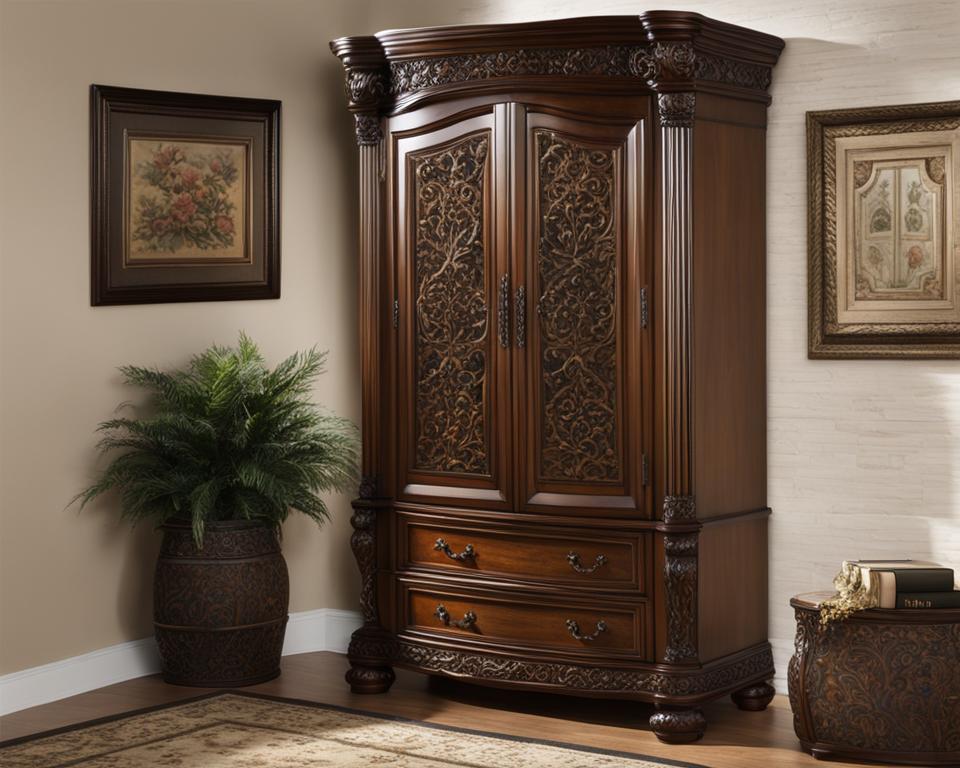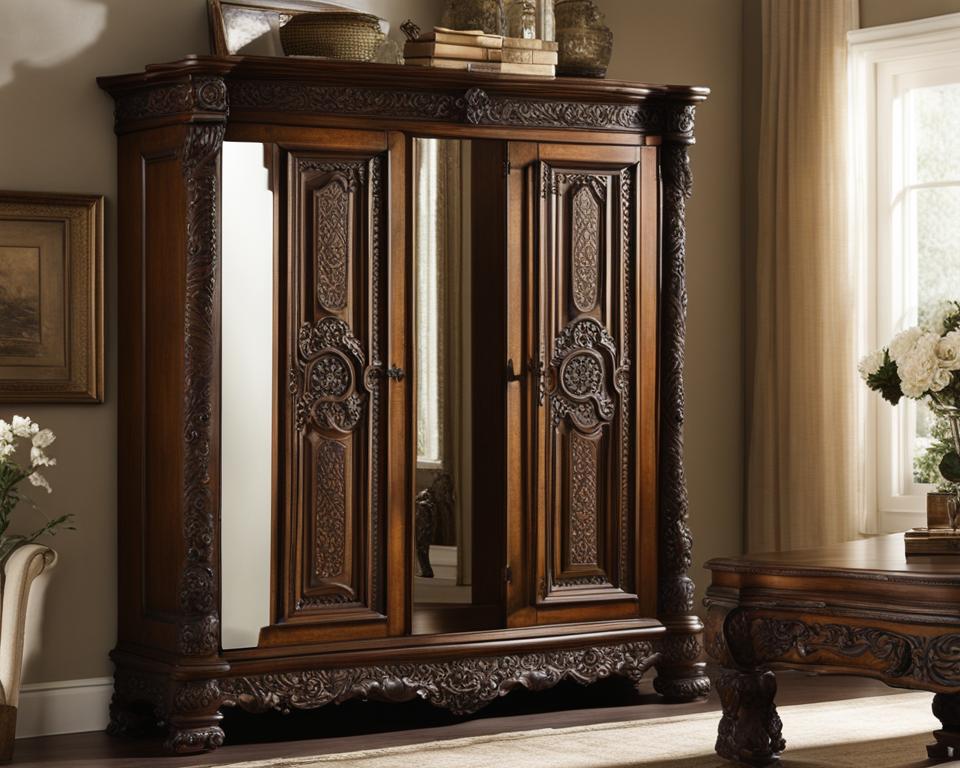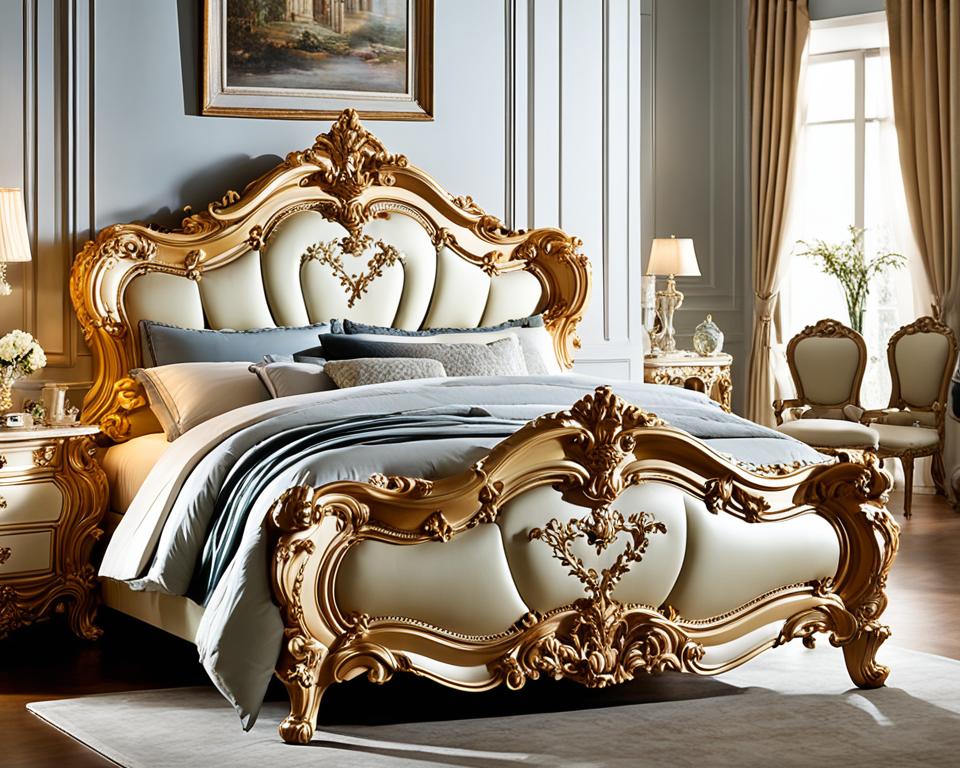
Antique armoires have stood the test of time as cherished pieces of historic furniture. These classic storage units, known for their exquisite craftsmanship, offer a touch of vintage charm and elegance to any space. Whether you’re drawn to the allure of a vintage wardrobe, the nostalgia of a retro closet, or the quaint beauty of an old-fashioned cupboard, antique armoires are prized collectible pieces that add a touch of sophistication and character to interiors.
Key Takeaways:
- Antique armoires showcase the artistry of woodworking and the timeless appeal of historic furniture.
- They offer versatile storage options and come in various styles, including Renaissance, Baroque, Louis XV, and Biedermeier.
- Restored antique furnishings bring a sense of history and authenticity to modern interior design.
- Whether used as a traditional cabinet, period piece, or a statement collectible, antique armoires add elegance to any space.
- With solid wood construction and intricate carving, these classic storage units are true works of art.
The Historical Origins of Antique Armoires.
The word “armoire” is derived from the French word “armoire,” which means a closet or cupboard. These furniture pieces have a rich history and have been in use for centuries, evolving in design and functionality to meet the changing needs of households. While antique armoires have their roots in French furniture design, they have been adopted and adapted by cultures around the world.
Antique armoires have a fascinating story that begins in France, where they were initially crafted as storage solutions for the elite during the Renaissance period. These opulent cabinets showcased the craftsmanship and artistry of the French furniture makers, with intricate carvings and attention to detail.
Over time, antique armoires became more accessible to different social classes, representing a symbol of wealth and status. Their design and features evolved, incorporating various styles such as Baroque, Louis XV, and Biedermeier, each reflecting the artistic influences of their respective periods.
“Antique armoires have a rich history that spans across cultures and time periods. Their origins lie in French furniture design, but their elegance and practicality have made them beloved pieces in homes worldwide.”
Antique armoires were not only functional but also carried a sacred significance. In many cultures, these cabinets were passed down through generations, storing treasures, heirlooms, and clothing. They were cherished family possessions, valued for their historical importance and the sense of continuity they represented.
Today, antique armoires continue to be treasured as valuable pieces of history, admired for their beauty, craftsmanship, and the stories they carry. These timeless pieces are sought after by collectors and interior design enthusiasts alike, and they provide a unique touch of elegance and nostalgia to any space.
| Historical Period | Main Characteristics |
|---|---|
| Renaissance | Intricate carving, architectural details |
| Baroque | Opulent design, elaborate carvings, gilding |
| Louis XV | Graceful curves, decorative motifs, rocaille carvings |
| Biedermeier | Simplicity, clean lines, natural wood finishes |
Key Characteristics of Antique Armoires.
Antique armoires are revered for their exquisite craftsmanship and timeless appeal. These beautiful pieces of furniture boast key characteristics that set them apart from modern storage solutions. From their solid wood construction to their ornate carving and versatile storage options, antique armoires possess a unique charm that complements any interior.
1. Solid Wood Construction
Antique armoires are typically made from durable woods such as oak, walnut, or mahogany. These robust materials not only ensure the longevity of the armoire but also showcase the natural beauty of the wood’s rich grain patterns. The quality craftsmanship and attention to detail in their construction make antique armoires sturdy and reliable storage solutions.
2. Ornate Carving
The intricate carving found on antique armoires adds a touch of elegance and sophistication to these pieces. The doors, panels, and sometimes the crown are adorned with detailed motifs such as floral patterns, geometric designs, or scenes from nature. This meticulous carving showcases the skilled craftsmanship of the era and brings a sense of artistry to the armoire.
3. Versatile Storage Options
Antique armoires offer versatile storage options to accommodate various items. They often include a combination of hanging space, shelves, and drawers, allowing you to organize and store different types of clothing, accessories, and linens. This versatility makes antique armoires not only beautiful but also practical and functional additions to any space.
4. Decorative Hardware
Antique armoires are often adorned with decorative hardware that adds both visual appeal and functionality. Brass handles and locks, for example, not only enhance the aesthetic of the armoire but also provide an element of security and privacy. These thoughtful details contribute to the overall charm and allure of antique armoires.
5. Authentic Patina
One of the most distinct characteristics of antique armoires is the authentic patina that develops over time. This natural aging process gives the wood a beautiful, time-worn appearance and adds character and authenticity to the piece. The genuine patina tells a story of the armoire’s journey through history, making it a truly unique and cherished item.
| Key Characteristics | Description |
|---|---|
| Solid Wood Construction | Typically made from durable woods such as oak, walnut, or mahogany. |
| Ornate Carving | Intricate carving on the doors, panels, and crown, depicting floral motifs, geometric patterns, or scenes from nature. |
| Versatile Storage Options | Combination of hanging space, shelves, and drawers for organizing clothing and linens. |
| Decorative Hardware | Brass handles and locks that add visual appeal and functionality. |
| Authentic Patina | Natural aging process that gives the armoire a time-worn appearance and adds character. |
Antique armoires embody the artistry, craftsmanship, and functionality of bygone eras. These key characteristics make them not only valuable collectibles but also unique additions to any interior. Whether you seek a statement piece or practical storage solution, antique armoires offer a combination of elegance and functionality that stands the test of time.
Styles and Periods of Antique Armoires.
Antique armoires have been crafted in various styles throughout history. Each style represents a specific period, showcasing unique design characteristics and influences. Understanding the different styles can help collectors and enthusiasts appreciate the historical significance and artistic beauty of these timeless pieces.
Renaissance Style Armoires
The Renaissance period, known for its cultural and artistic flourishing, influenced the design of armoires during this era. Renaissance-style armoires are characterized by heavy carving and intricate architectural details. These armoires are often grand and imposing, reflecting the opulence and grandeur of the Renaissance.
Baroque Style Armoires
Armoires in the Baroque style are renowned for their elaborate carvings and gilding. This style emerged during the 17th century and represents a time of artistic exuberance and embellishment. Baroque armoires are opulent and visually striking, making a bold statement in any space.
Louis XV Style Armoires
The Louis XV period, also known as the Rococo period, brought an aesthetic shift towards more delicate and graceful designs. Armoires in the Louis XV style feature elegant curves, intricate motifs, and a sense of lightness and airiness. These armoires exude a romantic charm and showcase the detailed craftsmanship of the Rococo era.
Biedermeier Style Armoires
The Biedermeier style emerged in the 19th century as a reaction against the extravagance of previous periods. Biedermeier armoires are characterized by their simplicity, clean lines, and understated elegance. These armoires focus on the natural beauty of the wood and showcase a more restrained design aesthetic.
When considering antique armoires, it is important to determine the style and period that resonates with your personal taste and interior design preferences. Each style offers a unique expression of craftsmanship, historical context, and artistic influence. Whether you are drawn to the grandeur of the Renaissance, the opulence of the Baroque, the grace of Louis XV, or the simplicity of Biedermeier, antique armoires are sure to add a touch of elegance and history to your space.
The Enduring Appeal of Antique Armoires.
Antique armoires continue to hold a special place in modern interior design. Their enduring appeal lies in their craftsmanship, versatility, and the sense of history they bring to a space. These timeless pieces of furniture, crafted with attention to detail and artistry, are highly valued by collectors, homeowners, and interior designers alike.
Originally designed for storage purposes, antique armoires have evolved to become statement pieces that add character and style to any room. While they still serve their traditional function of storing clothing and linens, antique armoires have found new roles in contemporary homes. They are often repurposed as unique wardrobes, housing televisions, or displaying cherished collectibles.
The vintage charm and elegance of antique armoires make them highly sought after by those who appreciate the beauty of classic design. These exquisite pieces showcase the artistry of woodworking, with intricate carvings, ornate details, and fine craftsmanship. Each antique armoire tells a story, with its age and patina adding to its allure. The rich history and sense of nostalgia that comes with owning an antique armoire make it a truly special addition to any living space.

Whether placed in a bedroom, living room, or dining area, antique armoires make a statement and become the focal point of a room. Their timeless elegance seamlessly blends with various interior design styles, from traditional to eclectic, adding a touch of sophistication to the overall aesthetic. The versatility of antique armoires allows them to enhance any decor, whether it’s a classic vintage-inspired room or a contemporary space that juxtaposes old and new.
When searching for an antique armoire, it’s essential to consider the size, style, and condition to ensure the perfect fit for your home. The market offers a wide range of options, from ornate Baroque designs to more understated and streamlined styles. Regardless of the specific design, antique armoires bring a sense of history, uniqueness, and enduring beauty to any space.
The Historical Origins of Rococo Beds.
The Rococo bed emerged during the 18th century, coinciding with the Rococo art and design movement in France. These beds are characterized by their opulent design and elaborate details, reflecting the frivolity and intricate decoration of the Rococo period. They were a departure from the formality and heavy ornamentation of the Baroque period, aiming to create an atmosphere of lightness and elegance.
An exquisite Rococo bed showcasing the opulent design and elaborate details of the era.
Key Characteristics of Rococo Beds.
Rococo beds are renowned for their exquisite beauty and opulent details. These beds showcase intricate carving, featuring motifs such as shells, scrolls, flowers, and leaves. The craftsmanship involved in creating these intricate designs is a testament to the skill and artistry of the artisans who crafted these beds. Additionally, gilding is often used to highlight the carved details, adding a touch of opulence and luxury.
The graceful silhouette of Rococo beds is another key characteristic. With curved headboards and footboards, these beds create a sense of movement and grace, adding a touch of elegance to any bedroom. The curvature of the bed frame reflects the emphasis on fluidity and lightness that defines the Rococo style.
Another notable aspect of Rococo beds is the sumptuous upholstery. Rich fabrics like silk, damask, and brocade are often used, contributing to the overall opulence and comfort of the bed. The choice of fabric further enhances the luxurious appeal of Rococo beds, inviting a sense of indulgence and relaxation.
“The intricate carving and sumptuous upholstery of Rococo beds exemplify the lavishness and attention to detail that define the Rococo style.” – Interior Design Expert
Many Rococo beds are canopy beds, further adding to their grandeur and romance. Elaborately draped curtains and valances create an enchanting ambiance, evoking images of royalty and luxury. The canopy design enhances the sense of privacy and creates a cozy sanctuary within the bedroom.
Overall, the key characteristics of Rococo beds include their ornate beauty, luxurious details, curved silhouettes, sumptuous upholstery, and often the presence of a canopy. These beds are true works of art and bring a touch of elegance and sophistication to any bedroom.
Comparison of Key Characteristics of Rococo Beds
| Key Characteristics | Description |
|---|---|
| Intricate Carving | Motifs such as shells, scrolls, flowers, and leaves. |
| Gilding | Gold leaf or gold paint used to highlight carved details. |
| Curved Silhouette | Curved headboards and footboards create a sense of movement and grace. |
| Sumptuous Upholstery | Rich fabrics like silk, damask, and brocade. |
| Canopy Design | Elaborately draped curtains and valances. |

Rococo Influences and Enduring Appeal.
The Rococo bed draws inspiration from the Rococo art movement, which emphasized asymmetry, frivolity, and intricate decoration. It was a departure from the formality of the Baroque period and aimed to create an atmosphere of lightness and elegance. Despite the passing of the Rococo period, Rococo beds continue to captivate with their opulent beauty. They are often used as focal points in bedrooms, adding a touch of extravagance and romance. Rococo-inspired elements can also be found in contemporary furniture and interior design, demonstrating the enduring allure of this style.
Key Features of Rococo Beds:
- Ornate and intricate carving with motifs such as shells, scrolls, flowers, and leaves
- Gilding using gold leaf or gold paint to accentuate the carved details, adding opulence
- Curvaceous silhouettes, including curved headboards and footboards, creating a sense of movement and grace
- Sumptuous upholstery with luxurious fabrics like silk, damask, and brocade
- Canopy beds, adorned with elaborately draped curtains and valances, exuding grandeur and romance
“The Rococo bed is a masterpiece of art and craftsmanship. Its intricate detailing and opulent design create a romantic and luxurious atmosphere in any bedroom.”
From the exquisite carvings to the sumptuous upholstery, Rococo beds have an enduring appeal that transcends time. The rococo influences can be seen in contemporary furniture and interior design, proving that the charm of this style continues to captivate homeowners looking to add a touch of elegance and grandeur to their spaces.
Conclusion
Antique armoires and Rococo beds are timeless treasures that continue to captivate with their beauty and craftsmanship. The Antique Armoire showcases the artistry of woodworking and the versatility it offers in terms of storage. Its solid wood construction, ornate carving, and durable materials make it a perfect choice for those seeking to add a touch of history and elegance to their homes.
The Rococo Bed, on the other hand, epitomizes opulence and decorative artistry. With its intricate carvings, gilding, and sumptuous upholstery, it creates a luxurious and romantic atmosphere in any bedroom. The curvaceous silhouettes and canopy design add an extra layer of grandeur, making it a striking centerpiece.
Both the Antique Armoire and Rococo Bed bring a sense of history, character, and luxury to modern interior design. Whether you appreciate the functionality of the Antique Armoire or the ornate beauty of the Rococo Bed, these timeless treasures are sure to add elegance and charm to any space. Incorporating these pieces into your interior design can transform a room into a sophisticated and inviting sanctuary, where timeless beauty meets functionality.
FAQ
What is an antique armoire?
An antique armoire is a vintage wardrobe or retro closet that serves as an old-fashioned cupboard or classic storage unit. It is a historic piece of furniture that adds a touch of traditional elegance to any space.
What are antique armoires made of?
Antique armoires are typically made from durable woods such as oak, walnut, or mahogany. These solid wood constructions provide strength and durability to the piece.
What are the key characteristics of antique armoires?
Antique armoires are characterized by their solid wood construction, ornate carving, and versatile storage options. They often feature intricate carvings depicting floral motifs or scenes from nature and offer a combination of hanging space, shelves, and drawers.
What are the different styles and periods of antique armoires?
Antique armoires come in various styles including Renaissance, Baroque, Louis XV, and Biedermeier. Each style has its own unique charm, reflecting the design influences and trends of its respective time period.
Why are antique armoires still popular in modern interior design?
Antique armoires are valued for their craftsmanship, versatility, and the sense of history they bring to a space. They can be repurposed as statement pieces or used for storage, adding character and style to any home.
What are the historical origins of Rococo beds?
Rococo beds emerged during the 18th century, coinciding with the Rococo art and design movement in France. They were characterized by their opulent design and intricate details, reflecting the frivolity and decorative nature of the Rococo period.
What are the key characteristics of Rococo beds?
Rococo beds are celebrated for their ornate beauty and luxurious details. They often feature intricate carving with motifs such as shells, scrolls, flowers, and leaves. The beds have curvaceous silhouettes, sumptuous upholstery, and are often canopy beds.
What influences can be seen in Rococo beds and why do they endure in popularity?
Rococo beds draw their inspiration from the Rococo art movement, which emphasized asymmetry, intricate decoration, and a sense of lightness and elegance. Their enduring appeal lies in their opulent beauty and the romantic atmosphere they create in bedrooms.
